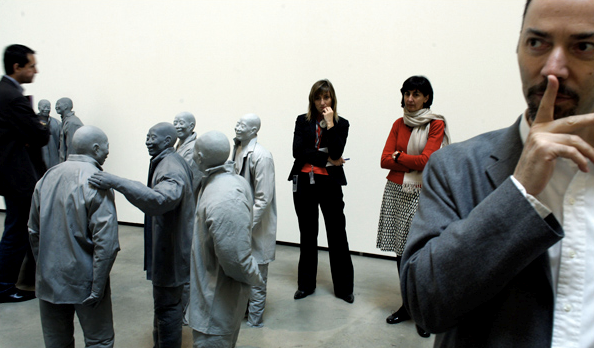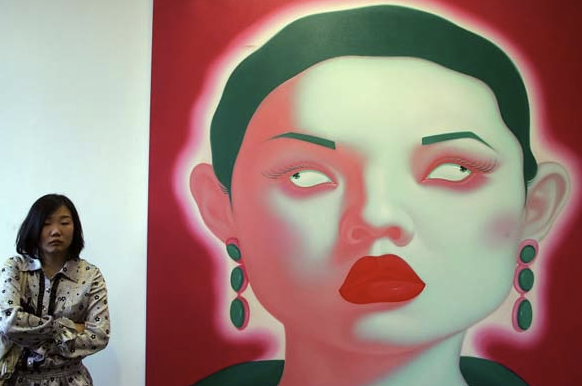One reason I enjoy art galleries is that they enhance the way I see the people around me. I begin to look at strangers with the same intensity given to the art on the walls. This gaze involves more than an eye for detail: people become at once universal and more perfectly unique. They become types yet acquire a distinctive aura. I see each one alone in existential space and yet rich with meaning and mystery. Above all, they become idealized. The beautiful people become more beautiful; those who look interesting become even more so; even those seemingly trapped, whether in low end jobs or their own stories, appear to be treasures of human experience and possibility.
That is not the only way to see, however, and two photographs in the same week seem to challenge exactly this attitude to idealize when seeing life as art. The first photo shows gallery visitors together with a sculpture by Juan Munoz.
The visitors are the ones in color. I can imagine a space alien having to ask and perhaps being disappointed on hearing the answer. Perhaps the grayscale figures suggest a statement about uniformity or collective happiness, but they do look better off than those around them. And not by accident. Munoz is quoted as saying that “The spectator becomes very much like the object to be looked at, and perhaps the viewer has become the one who is on view.” But not prepared to be on view. The spectators here each look as if unaware of being seen and the worse for that. The two women are pensive at best and perhaps depressed. The two guys appear to be studies in corporate indifference (on the left) and self-interested calculation (on the right). And whereas the statues are dressed in clothing that looks both comfortable and styled for being in public, the male spectators look dressed to code while the women look somehow uneasily thrown together.
This contrast between life and art is inflected further by this photograph:
The photo was taken at an exhibition in Athens, Greece of contemporary Chinese artists. The work on the right is no smiley face, but neither is the one on the left. The one on the right at least has the excuse of being a commentary on itself, not least on the effect of being pulled in opposing directions. Having no aura and holding herself protectively, the one on the left is several times diminished by contrast with the larger, stylized fashionista. If at this point someone were to retort, “yes, but she’s a real person,” well, then the game really is lost.
These photographs achieve exactly the effect that Munoz hoped to create with his art work: “the spectator becomes very much like the object to be looked at.” It’s a small step from there to imagining ourselves on display in a museum gallery. What would other viewers say? “They were a sorry species, weren’t they?” “Do you think their artists were as depressed as the rest of them?” “Maybe they were different in private, but you think it would show. . . .”
It would show, wouldn’t it? Or is it just that museums are depressing? Or are the photographs unfair? It is easy to answer no, no, and yes. These are real people with rich inner lives and many moods including the inward reflection rightly activated in a gallery and easily misread. But art is there to help us take a careful look at ourselves. If we really looked at one another, what would we see? What would the spectator’s gaze reveal if taken out of the gallery? What is there to be seen in public? Depression, fatigue, loneliness, exhaustion, failure? All of the above.
Photographs by Vincent West/Reuters and Louisa Goullamak/AFP-Getty Images. The work “Many Times” (1999) is comprised of 100 figures in a single room. A Tate retrospective on the artist earlier this year generated a number of reviews that are available online. The painting in the second photograph was not identified in the caption accompanying the image in a Manchester Guardian slide show.


Discussion